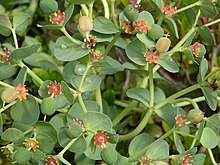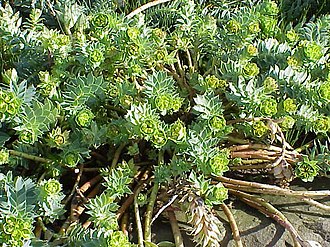Roller milkweed
| Roller milkweed | ||||||||||||
|---|---|---|---|---|---|---|---|---|---|---|---|---|

Roller Spurge ( Euphorbia myrsinites ) |
||||||||||||
| Systematics | ||||||||||||
|
||||||||||||
| Scientific name | ||||||||||||
| Euphorbia myrsinites | ||||||||||||
| L. |
The roller spurge ( Euphorbia myrsinites ), also called myrtle-leaf spurge , is a species of plant in the genus spurge ( Euphorbia ) from the family of the milkweed family (Euphorbiaceae). The German common name Walzen-Wolfsmilch refers to the cylindrical branches.
description
Vegetative characteristics
The roller milkweed is a succulent , evergreen perennial plant that reaches heights of up to about 15 centimeters. Its up to 30 centimeters long, prostrate branches appear at ground level and do not branch any further. The branches that carry inflorescences die off after they wither. The juicy, blue-green leaves are arranged in a tight spiral and partially overlap. All parts of the plant are covered by a layer of wax that allows rain to run off and thus effectively prevents wetting.
Generative characteristics
Depending on the location and the weather, the flowering time is between March and July. The terminal, trugdoldigen inflorescences are densely 8 to 13-rayed. The paired, rounded bracts and the cyathia are greenish yellow. The four nectar glands of the cyathia are oval to rounded trapezoidal, yellow to brownish (rarely purple) and have two finger- to club-shaped appendages on the outer edges.
Chromosome number
The number of chromosomes is 2n = 20.
Occurrence
The natural range of Euphorbia myrsinites extends from the Balearic Islands via Italy and Greece to Turkey and via Albania to southern Russia . It thrives between stones in open forests at altitudes of 1000 to 2300 meters.
In parts of the USA , plants introduced there are considered dangerous " weeds ". There is a law in the state of Colorado that prohibits the possession and planting of Euphorbia myrsinites . Landowners are obliged to remove roller milkweed from their land and receive illustrated instructions from the Ministry of Agriculture.
Systematics
Euphorbia myrsinites was first published in 1753 by Carl von Linné in Species Plantarum , 1st Edition, Volume 1, pp. 461-462. The specific epithet myrsinites is derived from the myrtle ( Myrtus communis ), with which Euphorbia myrsinites is said to have a certain similarity. Synonyms for Euphorbia myrsinites L. are: Tithymalus myrsinites (L.) Hill , Galarhoeus myrsinites (L.) Haw. , Endoisila myrsinites (L.) Raf. , Murtekias myrsinites (L.) Raf. , Euphorbion myrsinitum (L.) St.-Lag.
Of Euphorbia myrsinites there depending on the author about two subspecies:
- Euphorbia myrsinites L. subsp. myrsinites (Syn .: Euphorbia rigida . Loisel . illeg nom. Euphorbia curtifolia Chaub. , Euphorbia marschalliana Kotschy ex Boiss. , Euphorbia pectinata Albov , Euphorbia pontica Prokh. , Euphorbia myrsinites subsp. pontica (Prokh) R.Turner. ): You occurs from southern Europe to northern Iran .
- Euphorbia myrsinites subsp. rechingeri ( Greuter ) Aldén (Syn .: Euphorbia rechingeri Greuter , Tithymalus rechingeri (Greuter) Soják ): This endemic occurs only in Crete .
cultivation
The roller milkweed prefers warm and sunny locations with well- drained soils . Rock gardens , joints in dry stone walls and dry embankments are ideal . Standing moisture is not tolerated. Pests and diseases are extremely rare. Here in the trade offered plants to about -20 ° C hardy . A proliferation is determined by dividing the "root stock" or seeds possible.
Medicinal plant
Dioscorides wrote of the myrtle-leaf milkweed:
- The female, who is also called Myrsinites or Karyites, is similar to the Alpine two-beak and is well known. It has leaves similar to the myrtle, but they are larger and coarse, with sharp and thorny tips. From the root it drives long shots, it bears fruit from one year to the next, it is nut-like, gently biting on the tongue. This also grows in rough areas. Juice, root fruit and leaves have the same power as in the previous one ( Euphorbia characias ) ... The juice has the power to cleanse the belly downwards when taken in the amount of 2 oboles with vinegar water by removing mucus and bile discharges; but with honey water it also causes vomiting. The juice is obtained at the time of the autumn harvest; by putting the cut branches together, but you have to put them in a pot at an angle. Some also mix it with pea flour and use it to form pastilles the size of peas; Others drop three to four drops on dried figs, dry them and store them. But it is also kneaded on its own in a mortar and stored in pastille form. When extracting juice, however, you should not stand against the wind, or bring your hands to your eyes; rather, before you proceed to extract juice, you must anoint your body with fat or oil and wine, especially the face, neck and the scrotum. He makes the throat rough; therefore you have to cover the pills (bites) with wax or boiled honey and give them that way. Ingesting two to three figs is enough to effect purge. The fresh juice also removes hair when oiled in the sun. He makes the regrowing yellow and thin and ultimately destroys them all. It is also put into the hollow celita, since it relieves the pain; but you have to fill the teeth with wax so that it does not flow out and injure the throat and tongue. When spread, it drives away ulcers and pedunculated warts, as well as genital warts and lichen, and a good third is also used in overgrown nails and carbuncles, in cancerous, eating ulcers and fistulas. The fruit collected in late autumn and dried in the sun is also gently pushed and sieved and kept clean, the same thing happens with the dry leaves. But the fruit and the leaves do the same thing as the juice, if they are taken in the drink as much as half a vinegar. Some even canning them by adding cress and cheese tossed with milk. The root, sprinkled 1 drachm in honey water and drunk, also cleanses the stomach: cooked with vinegar as a mouthwash, it helps with toothache. ... , but that one is more exciting than this one.
gallery
swell
Individual evidence
- ↑ Euphorbia myrsinites at Tropicos.org. In: IPCN Chromosome Reports . Missouri Botanical Garden, St. Louis
- ↑ Colorado Department of Agriculture: RULES PERTAINING TO THE ADMINISTRATION AND ENFORCEMENT OF THE COLORADO NOXIOUS WEED ACT ( Memento of the original from November 11, 2005 in the Internet Archive ) Info: The archive link was automatically inserted and not yet checked. Please check the original and archive link according to the instructions and then remove this notice. .
- ↑ Colorado Department of Agriculture: Myrtle Spurge Control ( Memento of the original from October 6, 2007 in the Internet Archive ) Info: The archive link was inserted automatically and has not yet been checked. Please check the original and archive link according to the instructions and then remove this notice. (PDF; 186 kB) .
- ↑ a b c Rafaël Govaerts (Ed.): Euphorbia myrsinites. In: World Checklist of Selected Plant Families (WCSP) - The Board of Trustees of the Royal Botanic Gardens, Kew . Retrieved December 3, 2015.
- ^ Dioscurides: Materia Medica . ( Memento of the original from April 28, 2006 in the Internet Archive ) Info: The archive link was automatically inserted and not yet checked. Please check the original and archive link according to the instructions and then remove this notice.
Web links
- Euphorbia myrsinites, Myrtle Spurge. In: FloraWeb.de.
- Profile and distribution map for Bavaria . In: Botanical Information Hub of Bavaria .
- Euphorbia myrsinites L. In: Info Flora , the national data and information center for Swiss flora . Retrieved December 3, 2015.
- Thomas Meyer: Data sheet with identification key and photos at Flora-de: Flora von Deutschland (old name of the website: Flowers in Swabia )
- Data sheet with photos.
- Profile ( memento from November 25, 2003 in the Internet Archive )




